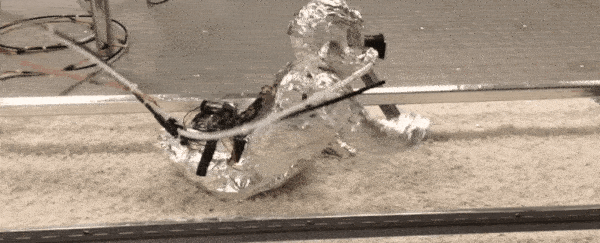It shouldn't come as a surprise to anyone that the carpets in your home are massive depositories of dirt, allergens, and microbes.
As we walk around, a lot of those particles get kicked up into the air, which has led some scientists to wonder - how much of this stuff would a typical crawling baby inhale?
Human offspring spend several months on their chubby hands and feet, exploring the environment before they can manage to stand upright. But they're tiny compared to adults, so it's possible they actually kick up less dirt.
To get some answers, a team of US and Finnish researchers first needed a baby that could repeatedly crawl across pieces of carpet in a controlled air chamber environment.
So, they went ahead and built one.
And while we appreciate the worthwhile endeavour that led to its production, the thing is so uncanny it's absolutely giving us the creeps.
Regardless of its appearance however, the team's "simplified mechanical crawling infant", fitted with a range of air sensors, successfully got through a total of 25 crawling experiments on five carpet pieces donated by actual residential homes in Helsinki.
For data comparison, the researchers also enlisted an adult volunteer equipped in a full body suit and filter mask to perform additional 25 walking experiments of the same duration and in the same conditions.
"We used state-of-the-art aerosol instrumentation to track the biological particles floating in the air around the infant in real-time, second by second," explains lead researcher Brandon Boor from Purdue University
What they found was that, per a kilogram of body mass, babies inhale four times the amount of biological particulate matter kicked up from the carpet as an adult would; the concentrations of this airborne floor debris can be as much as 20 times greater around the floor-bound babies.
"They really create this concentrated cloud of microbes around themselves as they crawl," says Boor.
But before you freak out about the wellbeing of the robot baby or your own crawling little person (hopefully cuter and covered in less aluminium foil), the researchers say that it's probably not as bad as it sounds.
"Many studies have shown that inhalation exposure to microbes and allergen-carrying particles in that portion of life plays a significant role in both the development of, and protection from, asthma and allergic diseases," says Boor.
What he's referring to is a concept known as the "old friends mechanism", a leading idea amongst allergy specialists suggesting that when we're exposed to a diverse range of largely harmless microbes early in life, it helps us develop a well-regulated immune system.
Overall, the team is really proud of their newly devised system that lets us find out more about babies' exposure to microbes, and the researchers are hoping to continue work in this area.
Let's just hope their next measuring device is less nightmarish.
The study was published in Environmental Science & Technology.
